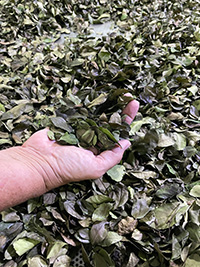Yaupon Holly Tea – Gardening Solutions (original) (raw)

Enjoying a warm cup of coffee or tea provides many a gardener with a jolt of energy to start their day. What if you could grow your own caffeine-rich tea leaves right in your backyard? Yaupon holly (Ilex vomitoria) is a native Florida shrub that makes a great tea alternative.
Now, don’t be scared off by the word “vomitoria” in its scientific name. It comes from yaupon tea’s historical association with purifying rituals where copious amounts of tea were consumed to induce purging. This should not deter the interested gardener; the tea will not cause intestinal distress when consumed in moderate amounts.
Emerging Industry
Yaupon holly tea is a crop that’s growing in popularity. There are several companies in Florida that are producing yaupon tea commercially, and now you can find it in many grocery and health-food stores. These companies typically harvest yaupon from the wild and/or have an agroforestry operation.
This is the process one such business, Yaupon Brothers, uses to prepare their yaupon tea:

- Once the leaves are harvested, they are washed and any stems, berries, or debris are removed.
- The leaves are then spread out and allowed to dry for several days.
- Once dehydrated, they are ground to the right consistency and dried in a oven at a low temperature. For fire roasted tea, the leaves are roasted in a pot over a fire by hand.
- The prepared yaupon leaves are then mixed with any flavorings or additions to the tea blend (such as mint or lavender).
- The last step is portioning the tea into tea bags, packaging them, and shipping them to yaupon tea lovers.
Harvesting
When harvesting your yaupon hollies for tea, make sure you don’t take more than one third of the tree’s canopy. You can either snap off branches and then pluck the leaves or strip the leaves from the plant while they are attached. The foliage will likely return within a week if you don’t break off the branches during harvest. There is no specific time to harvest or location on the plant to pull from; harvesting can happen anytime and anywhere!
Making Tea

Matt Palumbo, a UF botany master’s graduate, cooks yaupon holly branches prior to steeping them in hot water to make a beverage. UF/IFAS Photo by Tyler Jones.
Not only can yaupon tea give you a caffeine boost, this tasty tea can also give you a boost of antioxidants. Researchers at UF focused on the yaupon variety ‘Nana’ and found that the leaves had the same antioxidation potential as blueberries and as much caffeine as traditional green tea.
Antioxidants aren’t the only similarity between Yaupon tea and green tea; both can have a greenish color when brewed. Using fresh leaves will produce a green tea while using roasted leaves will produce a darker brown tea. As such, there may be some variation in how your tea looks, depending on how you prepare the leaves and how long you steep them.
Unlike other teas, yaupon holly leaves contain no tannins. This means you don’t have to worry about your tea becoming more bitter the longer you steep it. In fact, you can re-steep your tea up to three times without sacrificing flavor. Keep in mind that all the caffeine will be extracted during the first brew, so the re-steeped tea will be caffeine-free.
It’s important that you only brew tea from Ilex vomitoria, as there are a number of native holly plants and many of them are not safe for consumption. Also, remember whenever you try a new food to go slowly and make sure that you aren’t allergic to it.
For more information on yaupon holly, contact your county Extension office.
Also on Gardening Solutions
More from UF/IFAS
- Yaupon, a native Florida tea, is making a comeback — UF/IFAS Blogs Florida Small Farms
- Yaupon Holly Culture and Pest Management for Tea Production and Ornamental Use